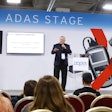
REPAIRING AN ELECTRIC VEHICLE IS ALL ABOUT HAVING THE RIGHT TOOLKIT
BY SARAH PERKINS, PHOTOS BY DAVID GILES
In early August, the Quebec government tabled a draft regulation towards the complete ban of the sale and renting of new internal combustion engine (ICE) vehicles starting in 2035 and Canada continues to make the push towards a greener future.
Like them or hate them, electric vehicles (EVs) are charging on the horizon and in order to keep up with the current of change, the modern repairer needs to know how to fix them. With their advanced technological parts and unique manufacturing, electric vehicles require a specific set of high-voltage how-tos—from tools to training—for a repairer to safely restore them to road-worthy conditions following a collision.
Keep reading to see what exactly should be inside of a repairer’s electric vehicle toolbox and to see what industry experts have to say about preparing for change.
THE ELECTRIC TOOLKIT
When fixing an electric vehicle, it is crucial to invest in the proper tools, technology and training. The high-voltage systems found within electric vehicles can present potentially life-threatening risks if a repairer does not know how to properly approach the technology. Read below to see a guide on what repairers should have in their toolkit when dealing with electric vehicles.
High-Voltage Safety Equipment
Working with the high-voltage systems found in electric vehicles requires specialized personal protective equipment (PPE) like insulated gloves, safety glasses and high-voltage resistant footwear. Repairers should also be equipped with insulated tools designed for high-voltage applications. These tools help prevent accidental electrical shocks when working on or around EV batteries and electrical components. Moreover, when looking at specific safety equipment, voltage detectors and insulation resistance testers are crucial for verifying that high-voltage systems have been de-energized before performing any repairs.
Battery Handling and Storage Equipment
Electric vehicle batteries are heavy and require specialized equipment for safe handling. As a result, battery handling systems, including lift tables and carts, can be used to help technicians move and manage batteries with greater ease and safety. Alongside this, secure and compliant storage solutions are necessary for safely storing removed or damaged batteries. These cabinets are specifically designed to handle the specific hazards associated with high-voltage batteries.
Another important battery handling tool|: fire suppression systems. In the instance of thermal runaway or other incidents, it is important to have a dedicated fire suppression system for electric vehicle batteries. Shops working on electric vehicles should ensure that they have fire extinguishers rated for electrical and lithium-ion fires.
Diagnostic and Calibration Tools
Due to their advanced technological and electric systems, electric vehicles often require specific diagnostic tools to interface with their onboard computers and sensors. Collision repair shops looking to work on electric vehicles should invest in advanced diagnostic scanners capable of reading and clearing codes, performing system tests and accessing manufacturer-specific data. Additionally, many EVs also require recalibration of sensors, cameras and driver assistance systems following repairs. Repairers should also make sure to keep up to date with the latest software updates for electric vehicles. Shops should ensure that they have the capability to perform over-the-air updates or access manufacturer software tools for updating vehicle systems.
Structural Repair Tools
Electric vehicles often rely on unique frame and unibody designs that require state-of-the-art frame straightening and measuring systems that can accommodate these structures. Technology such as heat induction tools are useful for reshaping metal without causing additional damage to the vehicle’s chassis. Laser measurement systems or other precision tools can also help repairers assess the vehicle’s intricate structures and to help maintain structural integrity.
Training and Certification
The EV landscape is constantly evolving and requires constant training to ensure repairers maintain a foundation of up-to-date knowledge. Many EV manufacturers offer certification programs to help technicians stay ahead. Check out this issue’s training course selections for more information.
Environmental Waste Management Tools
EV batteries and other components in electric vehicles must be disposed of properly to avoid creating environmental hazards. Collision repair shops intending to work on electric vehicles should investigate local bylaws in order to comply with area regulations for handling and recycling automotive waste.
ELECTRIFIED EXPERT INSIGHTS
EV Repair further reached out to electric vehicle experts David Giles, co-founder of ALL EV CANADA and Glenville Singh, Professor, School of Transportation at Centennial College, to find out more information about what repairers need to safely repair an electric vehicle.
EV specialist David Giles says safely repairing an electric vehicle, “requires some specialized tools and equipment. PPE includes insulated gloves, face shields, safety glasses and arc flash clothing to protect against high-voltage risks. Diagnostic tools like high voltage multimetres and insulation testers are crucial to help test and verify repairs.”
“Specialized tools for handling heavy EV batteries, high voltage disconnects and thermal imaging cameras can become necessary,” continued Giles. “Facilities need battery storage areas, shop safety equipment, space for the work to be performed and EV charging stations.
Additionally, shops need repair tools that are equipped to handle high voltage, such as torque wrenches and non-conductive panel removal tools to ensure secure connections and safe repairs. Continuous training and certifications like CSA High Voltage Safety are vital to stay updated on EV systems and protocols.”
When asked what safety procedures should be put in place to ensure that repairers can safely and effectively repair electric vehicles, Giles stressed that to have a safe and effective repair, “repairers should follow safety procedures.”
“These procedures include service disabling or disconnecting the vehicle’s high-voltage system electrically or mechanically and using insulated tools and personal protective equipment properly. Regular training on EV-specific safety protocols is essential alongside processes and procedure guidelines. “Repair facilities should have an emergency response plan in place, including a lockout/tagout system to help prevent accidental energization. Proper signage and barriers should be in place to keep unauthorized personnel away from high-voltage areas.”
Finally, when looking at training requirements, Giles highlighted that “to safely and effectively repair an electric vehicle, technicians must undergo specialized training.”
“This includes understanding high-voltage systems, battery management and electric drivetrain components. Training should cover diagnostic procedures, safety protocols for handling highvoltage battery systems as well as the use of specialized tools and equipment. Additionally, technicians need to be familiar with software updates and electronics unique to EVs.
“Certifications from recognized organizations such as I-CAR, ASE or CSA, enhance credibility and ensure industry standards. Continuous education is important due to the rapid advancement in EV technology, ensuring that technicians remain current with the latest repair techniques and safety practices.”
Comparatively, for Centennial College professor Glenville Singh, “the tooling for technicians to work on EVs has evolved from tools to get the work done to tools to get the work done safely for both the technician and others working in close proximity to the vehicle.”
“Some basic tools used include insulated tools, which are used whenever there is high voltage present or the potential for high voltage to be present. Category III or Category IV digital multimetres from a reputable manufacturer, these tools help meet the necessary safety requirements to measure the high-voltage found in EVs and also handle high transient voltage spikes.”
“Another important tool used on EVs is an insulation resistance metre used to measure lost isolation between the high voltage system and the vehicle chassis. From here, all technicians working on an EV should wear an arc flash suit with the appropriate arc flash rating for the vehicle being worked on. This suit should be worn when working on live high-voltage systems, or when disabling the high voltage system so it can be worked on safely or when the potential for high voltage is present.”
In terms of safe procedures, Singh stressed that “before work is carried out on an EV, the technician should disable the high voltage system following the vehicle manufacturer’s procedures. Proper training is vital for safe and proper repair of EVs. All personnel working on or around EVs should have at minimum, some level of high voltage training.”
Singh concluded that “at Centennial College, we offer EV training to any shop, dealership or fleet that would like to train their employees on the fundamentals of electric vehicles. There are two programs currently available; one course designed for the automotive sector where EVs are most prominent and the other tailored to the transit sector as most transit agencies are transitioning to electric-powered buses. The programs consist of six courses each centred around high voltage identification and safety personnel protection, tooling, disabling (lockout and tagout), high voltage battery, drive systems, high voltage control and high voltage accessories to high voltage system maintenance. The course also teaches basic failure and troubleshooting for electric vehicles.”



















